





Galega
Application instruction:
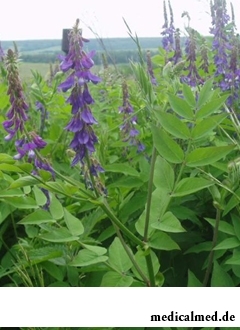 Galega – the perennial herbaceous plant belonging to family Bean.
Galega – the perennial herbaceous plant belonging to family Bean.
Description of a galega medicinal
The plant, from 40 cm to 2,5 m high, has a rod root. Stalks are upright, numerous, branchy. Leaves are petiolar, odd-pinnate, with stipules, with 5-10 couples of lance-linear leaves, and on a top – sharp-pointed.
Flowers most often of light blue color, numerous, with long pedicels, are collected in dense alar brushes. Nimbus of light blue or pale violet color, papilionaceous. The cup is campaniform. The plant yields polyspermous fruits, up standing beans from 2 to 4 cm long of Semyon smooth, pochkovidny, chartreuse color.
The plant in Ukraine (The Crimea, the Dnieper district, the Carpathians), in the Caucasus, in Moldova and in the European part of Russia (The Black Sea, Lower Volga districts) grows.
Grows on coast and valleys of the rivers, along roads, among bushes, in steppes and mountain areas, on edges, in beechen, in subtropical mesohylies.
In the medical purposes seeds and a grass of a plant (flowers, leaves, stalks) are used.
Chemical composition of a galega medicinal
The plant contains alkaloids, saponins and other nitrogen-containing connections: 4 hydroxygalegine, galegine.
Roots of a galega contain triterpenoida.
In a grass of a plant alkaloids, carbohydrates, пеганин, вазицинон and other nitrogen-containing connections were found: tannins, кемпферол, pipecolic acid, ascorbic acid, Rutinum, flavonoids, meletin, carotene, bitter substances, galegine, tannin, fenolkarbonovy acids and their derivatives in a hydrolyzate (p-coumarinic, coffee, ferulic, sinapovy).
Seeds of a plant contain sucrose, steroids, stachyose, alkaloids, saponins and other nitrogen-containing connections, fat oil, and also acids: stearin, linolenic, linoleic, palmitic.
Use of a galega medicinal
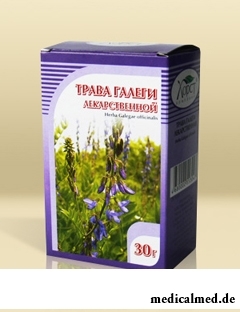 Effect of galegine in scientific medicine is investigated. At introduction to a vein it causes increase in blood pressure. At topical administration it narrows pupils. Galegine narrows vessels, oppresses motility of intestines and strengthens secretion of breast milk.
Effect of galegine in scientific medicine is investigated. At introduction to a vein it causes increase in blood pressure. At topical administration it narrows pupils. Galegine narrows vessels, oppresses motility of intestines and strengthens secretion of breast milk.
Galegine is applied at treatment of diabetes as an additional tool to treatment by insulin that allows to reduce its dosages. Infusions from seeds of a galega use in the same purposes.
The galegine which is contained in a grass renders hypoglycemic effect, and пеганин is capable to tone up smooth muscles.
Drugs of a galega have diuretic and sudorific action. At women in labor increase milk secretion.
In traditional medicine broths and infusions from a galega medicinal apply at a diabetes mellitus and also as anthelmintic means.
Galega medicinal – a melliferous herb
The Galega is recognized as the best melliferous herb for a long time. This plant is capable to give as much nectar how many and a sainfoin. The plant blossoms together with a white acacia – in the middle of May. Blossoming continues for a month. From one hectare of a bee collect about 200 kg of nectar. It is much easier for bees to pollinate this plant as in it there is no tripling that allows bees not to pinch a proboscis in the course of collecting nectar.
After the end of blossoming the grass needs to be mown, then the plant will blossom in August and will blossom to the middle of September.
Contraindications of a galega medicinal
It is necessary to use galega drugs with care. Their long reception causes increase in blood pressure and can break functions of intestines.
To pregnant women doctors do not recommend to use galega drugs. Hypotonia and a hypertension are also a contraindication to the use.
More than 500 million dollars a year are spent for allergy medicine only in the USA. All of you still believe that the way to finally win against an allergy will be found?
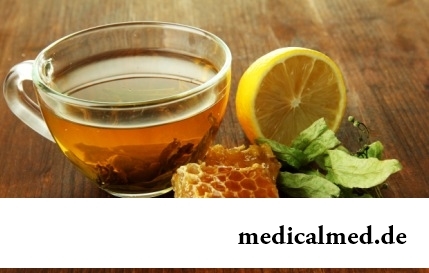
Cold – a state known to everyone which is followed by cold, cough, high temperature, a pharyngalgia. Often перво...
Section: Articles about health
The phenomenon of the panic attack is known long ago, but the reasons of its emergence still are up to the end not found out. It is established that more than 30% of people at least once in life become the victims of very unpleasant phenomenon: without everyones on that the reasons they have a feeling of horror, with...
Section: Articles about health
Each person knows that fervescence is an illness sign. However too low temperature (hypothermia), especially also can demonstrate existence of diseases when it is observed long enough. Such state is dangerous that it, unlike fever, does not give a serious inconvenience: patients usually complain only of weakness, drowsiness, apathy. Sometimes the fever and a cryesthesia in extremities joins. Many people at similar symptoms...
Section: Articles about health
Wood louse – the ordinary-looking unpretentious plant extended in all territory of our country. It quickly expands, and sometimes for...
Section: Articles about health
Dark circles (bruises) under eyes – a shortcoming with most of which often fight against the help of cosmetics (proofreaders, saloon procedures and so forth), eliminating only its visibility. However, according to doctors, skin around eyes – the indicator of many disturbances in an organism...
Section: Articles about health
Heart disease and blood vessels lead to disturbance of blood supply of bodies and fabrics that involves failures in their work, deterioration in health of the person, decrease in its working capacity and standard of living. Annually more than 17 million inhabitants of our planet perish from pathologies such....
Section: Articles about health
Use of medicinal plants in therapy is urgent today, more than ever. The drugs made of curative herbs cannot on...
Section: Articles about health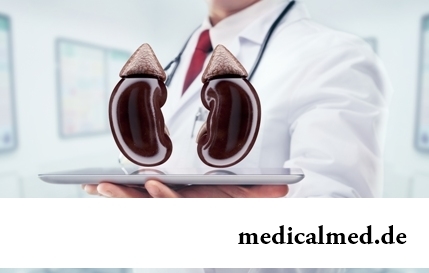
Kidneys perform the most important function of clarification of blood from those products of metabolic processes which cannot be used by an organism for obtaining energy and construction of new cells. With the urine produced by kidneys from a body of the person bulk is removed...
Section: Articles about health
Some people consider what for medicine of the 21st century of secrets in the field of health of the person almost does not exist. It absolutely not so. The more answers scientists receive, the more the most difficult questions are raised for them by life. Besides, there are diseases which are not explained with science in any way of which existence people know for 100-150 years. These diseases meet not so often, but from some of them nobody is insured....
Section: Articles about health
Deciding to get rid of an addiction, not all imagine what effects it is necessary to face. Process of refusal from ку...
Section: Articles about health
Popular joke that there are no healthy people, and is nedoobsledovanny, most of us considers an honest truth, continually it is necessary to hear that all of us are sick hardly from a school bench. It is hard to say, whether so it actually because...
Section: Articles about health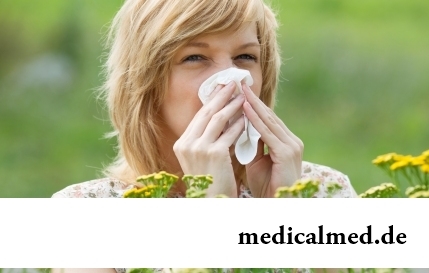
There comes the season of issues. Many Russians already dream of outdoor recreation, trips, beautiful seaside beaches. At this time there is no wish to think of problems with health and other unpleasant things, however there are subjects which require attention. In the summer repeatedly the risk increases to ache with some very dangerous illnesses, we also will talk about them today....
Section: Articles about health
80% of women at least once to lives complained of discomfortable feelings to breasts, consolidations and nagrubaniye. These are mastopathy symptoms. Mas...
Section: Articles about health
According to World Health Organization, every third inhabitant of Earth has excess weight, and every tenth has obesity. The reason of this phenomenon, according to specialists, roots in one not very comforting fact: most of people consume much...
Section: Articles about health
Each of us faces from time to time that other people need the immediate help. We react to it differently: one at once call doctors and police, others rush to victims and try to save them independently. Some pass by at all … Certainly, desire to help the neighbor who got into trouble, quite naturally for any decent person. However not everyone understands that to work in a similar situation, being guided by exclusively good...
Section: Articles about health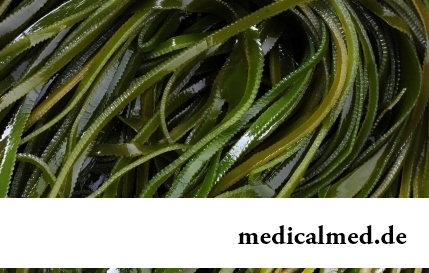
For residents of the countries of Southeast Asia various algas are an obligatory component of a daily diet. Their priest...
Section: Articles about health
The person, as well as all other beings living on our planet feels weather changing. It is the normal meteosensitivity which is not causing to healthy people of special troubles. Meteodependence, on the contrary, is morbid condition, характеризующимс...
Section: Articles about health
Stability of a hormonal background is one of the most important conditions of preservation of health of the woman. At the same time endocrine system – the thin device extremely sensitive to any external influences. Changes of a way of life (for example, a diet), emotional stresses, infectious diseases, reception of some drugs can become the reason of hormonal failure. Besides, work of hemadens has the natural specifics in certain moments of life: on various St...
Section: Articles about health
The state of health of the person in many respects depends on chemical composition of biological liquids of an organism. Specialists consider that з...
Section: Articles about health
Dietary supplements (dietary supplements) for the last decades were so thoroughly included into our life that, apparently, it is already impossible to find the person who at least once did not try them. At the same time, most of our compatriots have a vague idea about...
Section: Articles about health
What woman does not dream of a beautiful and thick hair? While physicians developed difficult schemes on hair transplant, in the industry of hairdresser's art a few years ago there was a sensation – methods of hair extension appeared. It would seem, dreams came true: though the procedure of building also does not belong to the category cheap, practically any woman can increase several times the volume of hair, change their length and color – generally, to become the real beauty queen....
Section: Articles about health
Cystitis, or inflammation of a mucous membrane of a bladder, this very widespread disease, which, owing to some persons...
Section: Articles about health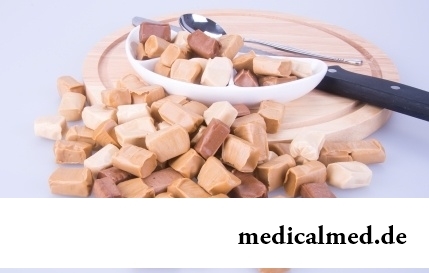
Food with the increased content of sugar is attractive to most of people - it is scientifically confirmed fact. Business here not in intemperance or dissoluteness: the sweet food is associated since childhood with feeling of rest and safety which is felt by the kid, to...
Section: Articles about health
Memory is an ability of the central nervous system to fix, keep and as necessary to reproduce information on knowledge or skills received by the person or an animal during life. The mechanism of this process is up to the end not studied....
Section: Articles about health
Herpes simplex of the first type (the infectious disease which is shown periodic bubble rashes on is called...
Section: Articles about health
Physical activity is necessary for normal functioning of a human body. At a lack of the movement joints cease to function, muscles atrophy, cardiovascular activity is broken and the metabolism worsens. Modern городс...
Section: Articles about health
All diseases from nerves – in this joke a big element of truth, are said by doctors. Constant stresses lead to decrease in protective forces of an organism, and it becomes vulnerable for a set of diseases. It is wrong to think that the stress is a problem of the present. Life of people and hundred, and one thousand years ago also abounded with problems therefore need of a relaxation understood in ancient times – to some techniques more than one thousand years. The person needs knowledge of how it is possible to relax, this knowledge пригод...
Section: Articles about health
